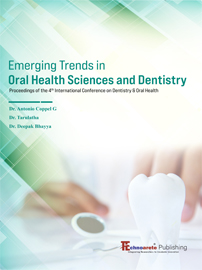


Deparment of Conservative Dentistry and Endodontics, Chettinad Dental College and Research Institute, Kelambakkam, India,
Deparment of Conservative Dentistry and Endodontics, Chettinad Dental College and Research Institute, Kelambakkam, India,
Deparment of Conservative Dentistry and Endodontics, Chettinad Dental College and Research Institute, Kelambakkam, India,
Deparment of Conservative Dentistry and Endodontics, Chettinad Dental College and Research Institute, Kelambakkam, India,
Deparment of Conservative Dentistry and Endodontics, Chettinad Dental College and Research Institute, Kelambakkam, India,
Deparment of Conservative Dentistry and Endodontics, Chettinad Dental College and Research Institute, Kelambakkam, India,
Deparment of Conservative Dentistry and Endodontics, Chettinad Dental College and Research Institute, Kelambakkam, India,
The Fourth Industrial Revolution is predicted to improve the quality of life by widespread, sophisticated developments in comparison to earlier industrial revolutions. In particular, the medical and life sciences are anticipated to play a pivotal role in this revolution. Artificial intelligence forms the key driver of this development. This exponential development in science and technology has established different applications, which are utilized in day-to-day life. This includes navigation maps, smart assistants such as Siri and Alexa, rideshare apps like Uber, spam filters, media recommendations and online banking. These applications forms the state of art in artificial intelligence technology. Artificial intelligence illustrate how technology is utilized to expand a software which can easily simulate human intelligence and successfully perform any sort of intellectual activity that could be taken by the human brain. This AI machines can even perform better at a task that is typically performed by humans. In the present day world, AI systems can imitate human cognitive skills like problem solving that makes it very useful in medical and dental field.
[1] Bellman Richard. Artificial intelligence: can computers think? Thomson Course Technology, 1978:146.
[2] Rajaraman V. John McCarthy Father of artificial intelligence. Reson. 2014:198e207
[3] Jef Akst. A primer: artificial intelligence versus neural networks. Inspiring Innovation: The Scientist Exploring Life, 2019: 6580
[4] Tripathy M, Maheshwari RP, Verma HK. Power transformer differential protection based on optimal probabilistic neural network. IEEE Trans Power Del 2010;25:102–112.
[5] Rabunal JR, Dorado J. Artificial neural networks in real-life applications. IGI Global: Hershey 2005:166e346.
[6] Suzuki K. Overview of deep learning in medical imaging. Radiol Phys Technol. 2017;10(3):257–273
[7] Alafif, T.; Tehame, A.M.; Bajaba, S.; Barnawi, A.; Zia, S. Machine and Deep Learning towards COVID-19 Diagnosis and Treatment: Survey, Challenges, and Future Directions. Int. J. Environ. Res. Public Health 2021, 18, 1117
[8] Shortliffe EH. Testing reality: the introduction of decision support technologies for physicians. Methods Inf Med 1989; 28:1e5
[9] Suzuki K. A review of computer-aided diagnosis in thoracic and colonic imaging. Quant Imaging Med Surg 2012;2:163–76
[10]Naranjo J, Poniachik J, Cisco D, et al. Oral Ulcers Produced by Mycophenolate Mofetil in Two Liver Transplant Patients. Transplant Proc. 2007;39(3):612-614. doi:10.1016/j.transproceed.2006.12.028
[11]Gaied H, Bacha MM, Mesbahi T, et al. Mycophenolate Mofetil-induced Oral Ulcerations in a Kidney Transplant Recipient. Curr Drug Saf. 2019;15(1):73-76. doi:10.2174/1574886314666191011153609
[12]Wang Y, Zhou J, Fu S, Wang C, Zhou B. A Study of Association Between Oral Lichen Planus and Immune Balance of Th1/Th2 Cells. Inflammation. 2015;38(5):1874-1879.
[13]Garrigue V.; Canet, S.; Dereure, O.; Panabieres, O.; Augias, D.; Chong, G.; Mourad G. ORAL ULCERATIONS IN A RENAL TRANSPLANT RECIPIENT: A
[14] Stiphout MAE Van, Marinus J, Hilten JJ Van, Lobbezoo F, Baat C De. Oral Health of Parkinson ’ s Disease Patients : A Case-Control Study. 2018;2018.
[15].Garrigue V.; Canet, S.; Dereure, O.; Panabieres, O.; Augias, D.; Chong, G.; Mourad G. ORAL ULCERATIONS IN A RENAL TRANSPLANT RECIPIENT: A
[16]Zhang, X., Liang, Y., Li, W., Liu, C., Gu, D., Sun, W., & Miao, L. (2020). Development and evaluation of deep learning for screening dental caries from oral photographs. Oral diseases, 10.1111/odi.13735. Advance online publication.
[17] How To Use A Fluorescence Microscope [Internet]. Lab Manager. 2020 [cited 28 June 2020]. Available from: https://www.labmanager.com/lab-health-and-safety/how-to-use-a-fluorescence-microscope-19863
[18] Zaza G, Leventhal J, Signorini L, Gambaro G, Cravedi P. Effects of Antirejection Drugs on Innate Immune Cells After Kidney Transplantation. Front Immunol.
[19]Schwendicke F, Rossi JG, Göstemeyer G, et al. Cost-effectiveness of Artificial Intelligence for Proximal Caries Detection. J Dent Res. 2021;100(4):369-376
[20]J. Vaarkamp, J.J. ten Bosch, E.H. Verdonschot, E.M. Bronkhoorst, The real performance of bitewing radiography and fiber-optic transillumination in approximal caries diagnosis, J. Dent. Res. 79 (2000) 1747–1751